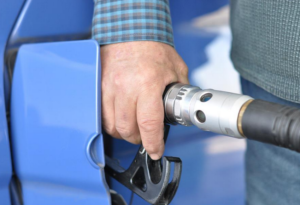Serving All Makes & Models Since 1947
651-228-1316
982 Grand Ave • St. Paul, MN 55105
Mon-Fri: 7am - 6pm
Electric Vehicles and 5 Things Every Car Owner Should Know About Them
With the increase in gas prices across the country, drivers everywhere are looking for creative ways to start saving at the pump. From getting more efficient in the way you drive to considering an upgrade to your vehicles, Minnesota drivers, like you, have been curious about electric cars. Whether you’ve checked into a new car at the dealer or seen ads on TV, electric cars are gaining in popularity so consumers can drive further for less money. If you’ve been considering whether an electric car can really save you money, then feel free to keep reading for some facts about electric cars.
How Electric Vehicles work
Before you get too far into purchasing that new electric car, you may want to know a little more about them. Electric vehicles, also referred to as Battery Electric Vehicles (BEV), use large battery packs to power the electric motor. If you purchase one, you won’t need to fill up on gas – instead, you’ll need to plug your car into a wall outlet (120V) or a charging station, also known as Electric Vehicle Supply Equipment (EVSE). When fully charged, most electric cars have a driving range of 200 miles.
Electric cars are not the same as hybrid vehicles. Hybrids use an electric motor, like an electric car, but combine that with a gas engine. Unlike electric cars, hybrids are powered by gas so your wallet will still feel that pinch at the pump. Due to the combination of an electric motor and a gas engine, these vehicles can go further on one tank of gas saving you some money (with less frequent fill ups), but not as much money as driving an electric car.
Lower running costs and Electric Vehicles
Most drivers want to know one thing when it comes to making the jump to an electric car. Will this really save me money? We’ve done the math and here’s what we found out. Electric cars cost $0.05 per mile to run vs. gas-powered cars that cost $ 0.15 per mile to run. That difference can be huge for any family when it adds up as the average electric car driver can save up to $4,000 per year in running costs. One last way electric cars put more money in your pocket? Rebates and tax credits. There is a federal tax credit for electric battery cars depending on the battery capacity, and the Clean Vehicle Rebate Project (CVRP) provides rebate savings for eligible vehicles.
Lower maintenance costs
With far fewer moving parts, electric cars don’t require the same kind of maintenance as gas-powered cars. They don’t require oil changes, new spark plugs, or fuel filters. Their batteries are typically lithium batteries which should be good for 300-500 cycles, or to put it in terms we know – they last about 10 years. Electric cars also feature regenerative braking where the car uses the electric motor to decelerate the vehicle, which extends the lifespan of your brake pads.
Cleaner environment
While an electric car can save you money, it can also save the environment. Studies have shown that electric cars are 85-90% energy efficient vs. gas-powered cars which are only 17-21% energy efficient. They also don’t have a tailpipe which means they don’t emit exhaust gasses cutting down on local air pollution when you drive.
Better driving experience
Most drivers of electric vehicles report a better driving experience. These cars feature quick acceleration, and produce peak torque from a standstill. Since the battery pack is positioned in the center of the car, electric cars have superior weight distribution and stability. They have great handling and are fun to drive.
If you’re ready to jump into buying your first electric vehicle, these 5 facts can help you make an informed decision. If you’re still unsure and have some questions, our team is ready to help. Simply call and we’ll be happy to answer any questions.
7 Steps to making your car more fuel efficient
A fuel efficient is important. As gas prices start to rise, Minnesotan drivers like you are feeling the pinch at the pump. You may have noticed that the current gas prices are enough to break your budget. While we can’t control the price of gas, the one thing we can control is how efficiently our cars are running. There are definitely some simple steps you can take to make each fill up last longer and get you driving father.
Check your tire pressure
Your tires not only ensure safe driving, they also contribute to fuel efficiency. When your tires are not properly inflated, they can decrease fuel efficiency by 3%. While this might seem like much, this can add up over time. To improve your fuel efficiency, plan on checking your tire pressure on a monthly basis to ensure your tires are properly inflated.
Check your front end alignment so it’s efficient
Spring is basically pothole season. If you’ve had any recent run-ins with a pothole or hit a huge bump, your front end could be out of alignment. When your car is out of alignment, your gas mileage can decrease by up to 10%. Signs your car is out of alignment are pulling to one side when driving, shaking when driving at high speeds, or a little extra bounce when hitting a bump. If you notice any of these symptoms, having your alignment checked out can get you saving money at the pump in no time.
Check your trunk
If you’re one of those people that throws everything in the trunk, you might want to rethink your strategy. The heavier your car is, the harder it will need to work which can affect your fuel efficiency. Did you know that for every 100 lbs of items you store in your trunk, your fuel consumption goes up by 1-2%? If you’re ready to save on gas and go longer in between fill ups, storing those heavy items in your garage instead is a good idea.
A Fuel Efficient Car
You may have heard or even assumed that a higher octane gas will lead to greater fuel efficiency. Filling up with a higher octane when your car doesn’t need it will simply cost more without any added benefit. It’s a good idea to check what octane level your car really needs. If your car requires 87 octane fuel, filling up with 89 or 91 octane won’t increase your fuel efficiency. While we’re talking about filling up, it’s always better to keep your tank above ¼ tank full. When your tank gets below that, your fuel pump has to work harder which leads to a decrease in fuel efficiency.
Check your idling time
You may be tempted to let your car idle while you’re waiting for your friend, checking your messages, or even waiting for your next appointment. But did you know that your car consumes ½ a gallon of gas for every hour of idling? Consider rolling down your windows and enjoying the beautiful spring weather instead.
Check your AC usage
When it comes to those dog days of summer, using your AC prematurely and when it’s fairly nice out can decrease your fuel efficiency. For city driving where you are doing a lot of stopping and starting, keeping your windows open and turning off your AC can increase your fuel efficiency. As far as highway driving goes, keeping your windows rolled down can reduce your fuel efficiency by 10%.
Check your car maintenance schedule & have an efficient car
Your car can burn up to 30% more fuel if proper maintenance is not regularly performed on your vehicle. Scheduling regular maintenance can keep your car running efficiently all year long and can include checking your tire pressure, your front end alignment, replacing your air filter (which can help increase fuel efficiency), and other routine checks to ensure fuel efficiency.
If you’re ready to start saving money at the pump, and stretching that full tank of gas, then these 7 steps will help. Our team is ready to help you get your car in shape for fuel efficiency this spring. Simply make an appointment and we’ll check to make sure your car is running more efficiently no matter where you drive it.
How a Pothole Can Damage Your Car This Spring
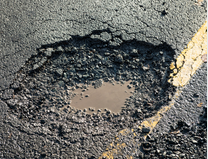
You may have already noticed while you’re driving around town this spring – it’s pothole season. As winter snow and ice starts to melt and refreeze underneath the pavement, potholes begin to form on the surface. Potholes are a nuisance on the road and a hazard for Minnesota drivers. We can avoid potholes by slowing down and paying attention to the road while driving, but every once in a while, potholes are unavoidable. Potholes can definitely cause damage to your car each spring. If you’ve been wondering what kind of damage to look for, we’re unpacking some areas to inspect after running into that pesky pothole.
Pothole damage to the Tires & Wheels
Tires take the brunt of the impact when you inadvertently run into that pothole. The first and most obvious damage we tend to see is a flat tire. While flat tires are a sign of damage to your car, it’s also best to check all four tires for internal tire damage. Running into a pothole can break the interior structure or sidewall of your tire which can lead to blowouts while driving if left undetected. Look for bulges or bubbles on all four tires to ensure there is no interior damage.
Your wheels can also sustain damage especially if your tires are not inflated properly. Wheels can bend, crack, or even break upon impact, making them an important part of your vehicle to check after hitting a pothole. Repair options tend to be limited for wheels, so you may need to ask your mechanic about replacing any that are damaged.
Suspension & Alignment after hitting a Pothole
Your suspension system can take a hit when you drive over that pothole as well. Parts like your suspension arm or tie rod are susceptible to breaking. In addition, running into that pothole can knock these systems out of alignment. If you notice that your car is pulling to one side or the other while driving, shaking when you drive at high speeds, bring it in. You may also notice it keeps bouncing for a while after you’ve hit that bump, then it may be time to have your suspension and alignment looked at. Neglecting poor alignment can cause tires to wear unevenly or wear out prematurely, which can lead to safety issues while driving around town. If you’ve hit a pothole recently, it’s always a good idea to have your mechanic inspect your suspension system for damage.
Shock Absorbers
Driving into a pothole can also cause damage to your shock absorbers. These can break on impact. Your shock absorbers were designed to ensure a smoother ride, and better vehicle handling. When damaged, you may notice nose diving when braking, wheel vibrations, and leaking fluid. You can also test your shock absorbers by pushing down hard on the front corner of your vehicle 2-3 times. If your car continues to bounce several times after you stop pushing, schedule an appointment with us.
Exhaust System
Last but not least, your exhaust system can be damaged when you drive into a pothole. The impact with a pothole can cause your exhaust system to break loose or bend. Some signs of a broken or damaged exhaust include strange noises coming from your backend. It may also have decreased power and acceleration, and decreased fuel efficiency. If you notice any of these symptoms after driving through a pothole, it’s best to make an appointment so your mechanic can take a look.
While no one wants to hit a pothole, some potholes are unavoidable as you drive around this spring. If you happen to unexpectedly hit one, our team is ready to inspect your vehicle for any damage. This will ensure that your family is safe wherever the road may take you.
5 Ways to tell if your car needs a Spring maintenance check
 Spring maintenance is needed for your car. The signs that spring is coming are here. From melting snow, potholes on the roads, small buds on the trees, and warmer temperatures, we can read the signs and know that we’ve made it through a long Minnesota winter. Just like the coming of spring, your car also will give you signs that it’s in need of some care, and if you haven’t guessed already, we highly recommend a spring tune up for your car every year.
Spring maintenance is needed for your car. The signs that spring is coming are here. From melting snow, potholes on the roads, small buds on the trees, and warmer temperatures, we can read the signs and know that we’ve made it through a long Minnesota winter. Just like the coming of spring, your car also will give you signs that it’s in need of some care, and if you haven’t guessed already, we highly recommend a spring tune up for your car every year.So, how do you know if your car needs a spring tune up? We’ve got you covered with 5 ways your car is telling you it needs a tune up.
1. Your drive feels rougher than it used to
Our winter weather can be rough on our cars, especially our tires. If your ride doesn’t feel as smooth as it did last fall – it may be time for your spring maintenance check. Your mechanic should be rotating and balancing your tires regularly. Spring is also a great time for your mechanic to inspect the tread life left on your tires and your rims for any damage from your winter driving.
2. Steering seems more challenging
One sign that your car needs a tune up is that steering seems more challenging. Winter can mess with our alignment and suspension. One way your car tells you it needs an alignment check is pulling to one side or the other while driving. If you feel like you’re fighting with your steering wheel to drive in a straight line, it’s time to fix your alignment. When it comes to your suspension (shocks and struts), you may notice shaking at high speeds, trouble turning corners, and continued bouncing long after you hit a bump. If you notice any of these steering challenges, then a spring maintenance check is a good idea.
3. Night time visibility is difficult
Did you know that winter weather can cause yellow and hazy headlights, taillights, and turn signals? Yellowed lights will decrease visibility and increase your safety risk while driving at night. If the roads seem less clear at night, it may be a sign that your car needs a spring tune up. Ask your mechanic to replace yellowed lights and replace any burnt out bulbs. While we’re talking safety and visibility, we highly recommend replacing your windshield wiper blades. Winter can dull your blades and replacing them in spring will ensure you are ready for those spring rains. If your view is unclear, take your car in for your spring maintenance check to ensure safe visibility at all times of the day.
4. Your engine runs louder
After a long and bitterly cold winter, your engine could start making some noise. If you notice that your car seems to run a little louder than it did in pre-winter weather, your vehicle may be due for a little TLC. Our bitterly cold temperatures can cause cracking, and tearing to our belts and hoses which can lead to breakdowns on the side of the road if not addressed. Your mechanic should check the condition of your belts and hoses each spring which will give you peace of mind while driving around town or on that next road trip.
5. Your indicator lights are shining
This may seem like a no-brainer, but your indicator lights are a sign that your car needs some attention. When you schedule your spring maintenance check, you’ll want to make sure your mechanic checks your fluid levels like, coolant, transmission fluid, power steering fluid, and brake fluid. In addition, spring is a great time to replace your cabin air filter which protects the inside of your car from allergens and pollutants. Ensuring these small things are checked can go a long way for enjoyable spring driving.
While your vehicle may not physically talk to you, your car will let you know when it’s time for a spring maintenance check. Spring is always a great time for a reset when it comes to your car maintenance to ensure safe and smooth driving all year long.
Are Surging or Pulsating Brakes a Safety Issue?
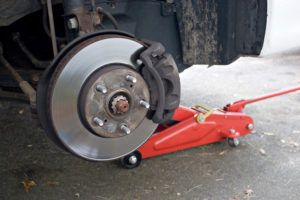
Surging brakes mean there is an issue. If you step on the brake and the pulsation is minor in your steering wheel and seat, then you may not have to worry about it. Sometimes the brake pulsation can be out of control, and once you step on the brake, the car vigorously shakes.
This can lead to a much more difficult situation. Excessive pulsation of the brakes can be a safety concern especially during slippery road conditions. The reason why your brake is pulsating is that that brake calipers are unable to grab hold of the rotor. This can cause a slipping or sliding predicament.
Fixing the Problem
The first step towards fixing the pulsating brake issue is determining the cause of the pulsation. It is worth noting that a surging or pulsating brake can stem from plenty of different causes. One of the most common causes of pulsation is warped rotors. Rotors are components that undergo plenty of friction and heat since the brake pads press upon their surface whenever you step down on the brakes.
For this reason, you can experience minor tremors in either the steering wheel or from under your car seat if you have been practicing particular driving habits. These driving habits pertain to jamming the brakes too hard. However, a person can be forced to do this if they are driving during inner city rush hours, or even at a steep slope.
Excessive and forced braking will ultimately cause wear on the rotors, which will lead to damaged rotor surface. However, this is not the only way a car’s rotor will undergo stress due to braking friction. Once you have determined the particular issue that is causing the friction, then you must correct that issue.
Solutions for Surging Brakes
If you find that the pulsating tires is only because of warped rotors, you need to make sure that you are replacing the rotors with the pads. This is regardless of what conditions the pads were in, even if they are brand new. The reason for that is that the surface of the pad needs to come in contact with the surface of the rotor.
If you decide to cut costs and only replace the rotors, you will end up experiencing brake noises and a pulsating effect as well. The rotors that you find today consist of much thinner material and people try to keep them at a very minimum specification, which helps keep the vehicle lighter and is also more fuel efficient overall.
Cutting the rotor’s thickness will present issues. By the time you dig into where the metal is good, the rotor will become very thin. This would not be good if you have very thin brake rotors. They are not going to be able to dissipate the heat overall and the brakes will not function as they should.
You should not confuse a brake pulsation with any other problems. Some people confuse with ABS unit activation. You have to therefore know how to identify brake pulsations.
Reasons to Keep an Eye on Your TPMS Light
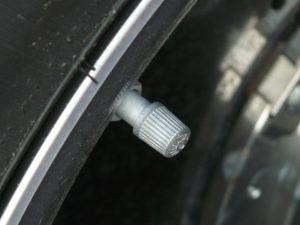
Tire pressure not only impacts your control over the vehicle during the journey but also keeps the drivers safe when they apply brakes. We understand that the classical way of testing tire pressure is getting out, seeing if any of your tires seem low on air pressure, and getting them fixed accordingly.
However, there are a few modern methods of checking the TPMS for tire pressure. The TPMS includes a light indicator that shows up when one of the tires in your vehicle has low air pressure and needs a routine check.
We are going to talk about the reasons why a TPMS light is important and how it can help you during your journey. So, ensure reading till the end of this article.
Reasons to Check Your TPMS Light
There are various reasons why checking your TPMS light before and during the journey can help benefit you. These reasons include the following
Preventive Measure
The TPMS light indication is more of a preventive measure that focuses on providing an indication when the tire air pressure is at a risky state. While the indications show that the tire pressure is below average, it is not immediate. Drivers can easily take the vehicle to a tire or repair shop and get it fixed on time. This simple TPMS can help reduce the chances of inconvenience due to tire trouble later on.
Might Indicate Other Issues
A TPMS is not only useful for indicating possible flat tires only. It can warn drivers about other possible problems as well. For instance, your tire may be running out of air merely because of leakage, or a simple issue, that you can fix on time, and stay on track with your trip. This feature helps because the TPMS light indicates potential problems even when the tires look fine on the outside.
Reads External Temperature Changes and the TPMS
The TPMS system can help you keep your vehicle well-maintained even at severe climatic changes. For example, drivers in cold regions face a lot of tire pressure issues. Most of them end up with a flat tire because they didn’t know about air pressure on time. We suggest these drivers keep an air gauge with them in their car and check it when needed.
Chances are that you do not need to fix your tire, or get it changed, as refilling the tire air pressure does the trip, and saves you from punctures.
Saves Time
While a flat tire is not always a life-threatening situation, getting it fixed wastes a lot of time. This includes dragging the car to a safe spot, waiting for the mechanic to show up, or keeping yourself safe until the necessary help arrives. However, checking the TPMS light on time can help reduce this problem, and keep your car running on the road smoothly. You can save hours of hard work if you check the TPMS indication as soon as you suspect something. A TPMS light is a great way to keep an eye on the tire pressure in your vehicle, take it for maintenance on time, save time, and reduce inconvenience. We suggest you keep basic repair tools in the vehicle with you and see a tutorial or two on how to refill the tire air pressure yourself.
Snowplows and Tips for Driving this Winter

Snowplows need space while operating. When driving around during winter, you’ll need some practice in how to safely and effectively drive in slippery and snowy conditions. Also remember to leave enough space between you and them. If you are driving a front-wheel drive, keep in mind that you will have a different experience than an all-wheel-drive car.
This is because the driving wheels will also be the wheels that are turning the vehicle and doing most of the braking. Ideally, you should drive at a speed that offers you the best stability and control so that you can avoid common hazards such as rocks, ditches, and bumps.
Be Smooth on Your Controls
The most important thing about driving in the snow is to be incredibly smooth on your controls. This means that you should not hit the throttle too hard because you will start to spin your tires. You also have to avoid braking too hard because you will either lock up or kick the ABS on. Of course, try not to make instant steers to the left or right.
The next thing that is extremely important when driving in the snow is preparation and planning. Before you even start your car for a winter commute, make sure that you check the weather forecast and take all the road clearance updates beforehand.
By doing this, you can better plan and schedule your commutes for the safest experience possible. However, the winter season is unpredictable, and you must always prepare for danger and hurdles. You should also be planning ahead while you are driving so that you are not caught in instantly applying the brakes and losing traction on an icy surface.
Driving around Snowplows or Trucks
When you see a plow truck ahead and notice different types of fluids coming out of it, make sure that you are at a distance. Getting too close to the plow truck will compromise your visibility since there is often a cloud of snow that builds alongside the truck.
Plow trucks will typically travel at a speed of 25 to 45 miles an hour. If you are in a hurry and must pass, it is best to wait until the visibility around the plow truck is better. If you cannot see, then do not try to pass through the snowplow.
However, if there is significant visibility, you can pass through it. When passing, allow plenty of room and be prepared for the conditions that you will come across in front of the plow. You can also wait for a few miles since the plow is likely to turn around and head in the other direction shortly.
Follow a plow too closely, and you will risk damage from the spread of ice-melting sand. Plows can also cause the road debris to shoot up and also drop huge chunks of ice on the road.
Overall, there is plenty of ice that can build up on the plow trucks, and it can fall behind on cars. The best advice would be to slow down and stay back. Do not crowd the plow, and always be safe.
Winter driving – Storm Survival Tips
 Winter driving and staying safe is important. Winter is here, and in many parts of the country, there is a great chance that a snow storm will hit. This is not only annoying, but also life-threatening for people. Thus, before winter starts to pour down heavy snow with high magnitude wind, you must be ready to face it head on and survive. You want to make sure that you have all the resources for safety and survival ahead of a worst case scenario.
Winter driving and staying safe is important. Winter is here, and in many parts of the country, there is a great chance that a snow storm will hit. This is not only annoying, but also life-threatening for people. Thus, before winter starts to pour down heavy snow with high magnitude wind, you must be ready to face it head on and survive. You want to make sure that you have all the resources for safety and survival ahead of a worst case scenario.
What to do when stranded
People can get stranded in the winters, and regardless of what you may think, it can happen to you as well. There are times that big snow storms emerge unpredictably and you can either get stuck on a ditch, get caught in heavy snow, or get stranded due to zero visibility and dead battery.
One of common mistakes people make when they cannot start their car, especially if they are with family members, is to leave the passengers seated and head out into the snow storm. This only puts your life at risk even more. Staying put in the car increases your odds of being noticed by emergency workers or other cars.
This is why everyone in the car should stay put and try to contact rescue services. When it comes to putting on the heater, you want to make sure that you do not freeze to death in the car, but also not run out of fuel at the same time.
Experts say that the best formula for the heater is that you should run it only ten minutes an hour. This does not have to be the same ten minutes, and you can intermittently blast the heat in the span of that hour for a total running time of ten minutes.
Winter Driving and the Essentials
Whether you are expecting a snow storm or not, always travel with a water bottle, and snacks. Other important essentials include first aid kit, medicine, blankets, hand warmers, flash lights, and more. Hand warmers and blankets can be critical in keeping you warm for the time that you do not have the heater on.
Keep Tailpipe Clear from the Snow
You want to make sure that your tail pipe does not undergo blockage from the snow. If you get stuck, and there is snow against your tailpipe while it is on, then harmful gasses such as carbon monoxide can seep into the air vents and cause fatal instances. This is why, it is incredibly important for you to run back to the rear side of the car and clear the snow.
Winter driving and Rock Salt Alternatives
Ideally, you want to make sure that you are equipped with rock salt. However, if you do not have that, you can use a homemade alternative to clear ice from your pathway. It involves mixing rubbing alcohol and dish soap with hot water, which provides you with an effective solution for melting the ice.
When in possession of the right resources, and with the knowledge of the right tips and tricks, you can survive a stranded occurrence. So make sure you are prepared for winter.
Winter Safety Kit for your Car
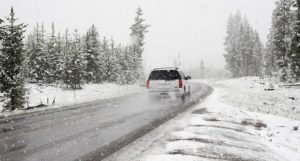
Safe driving in the winter time is a serious consideration for drivers. The dire cold temperatures and iced up parkways and roads lead to situations that are unfavorable for cars, drivers and commuting. Despite the critical conditions, drivers still need to fulfill their commuting needs. When driving in the snow, you need to be very aware of all the nuanced danger threats that could be lurking.
Winter preparedness is all about anticipating the threats and dangers prior to driving and equipping the car with maintenance and gear that will help against hazards and unwanted occurrences. Another important step when heading out in the snow involves planning the route and scheduling the commute according to weather forecasts.
Sitting back when the weather is expected to become hostile can be a life-saving decision. When stranded in the snow, having sufficient supplies and gear can be pivotal. This is why you must build a winter emergency kit and stock it with the necessary supplies.
Creating a Winter Safety Kit
Safety professionals highly recommend people to have a winter safety kit inside every vehicle. Every winter kit should include a bag pack. This bag pack should hold essential items for your winter safety. These items include gloves, food, matches, lighter, water and more.
Food and drinks are important in the occurrence of being stranded in the snow. When stuck, it is crucial to stay hydrated and nourished so that you can make the right decisions. When it comes to gloves, it is very important that you keep extra pairs since they are not only beneficial for keeping you warm, but they also help protect your hands when you are performing maintenance checks.
Other Important Considerations
Not to mention, you should also include some sources of light in the bad pack. This can be in the form of flashlights or flares. Keep in mind that when driving in the winter, you are more likely to be driving in the dark. Having a high beam portable flashlight is an excellent way to enhance your visibility while on the road.
Other than that, when stuck inside the snow overnight, temperatures can drop to deadly levels. You cannot keep the car functioning because of limited fuel. It is best to switch the car on for ten minute intervals every hour and wear extra layers to compensate for the time you spend without the heater. Thus, always be ready with additional jackets, wearables, and blankets in the car.
Air compressors can also serve as incredible additions to your survival kit. It is very important for your tires to be in optimum air pressure so that they can facilitate your car with the right amount of traction. An air pressure gauge and compressors are therefore incredible choices to pick from.
The above mentioned items are more specific to winter hazards, and it is important that you do not forget about items that are critical year round. These include jumper cables, extra fluids, scrapers, brushes and shovels.
Car Battery Issues and Preventative Solutions

The cost of car batteries is only going to increase as time goes on. This is why you want to make sure that your battery lasts as long as possible, especially in the cold weather. To keep the battery working efficiently, make sure to follow regular maintenance and replacements. If you want your car battery to not trouble you this winter, follow these recommendations.
Car Battery Usage
The car batteries are not like the batteries inside your cell phones. When you use your smartphone, you notice a drain in the battery and it runs out if you do not plug it in. However, car batteries function differently. They help power your car so that it can start, and once your car has started, then the alternator recharges the battery and runs the engine.
Car batteries are supposed to discharge, start the car, and get recharged by the alternator. If you let a car battery rest without working, then you can expect it to stop functioning. If you do not use your car much, then you can use tools that charge your battery without you having to drive it.
Tools such as these can be very useful in the colder seasons when most people like to stay indoors and car usage decreases significantly. You want to keep the battery running so that you do not have trouble starting it when you need to go somewhere due to an emergency.
Keep the Terminals Clean
You want to make sure that your battery terminals are clean and corrosion-free. This is because corrosion or lose terminals create more resistance. The more resistance inside the electrical circuit, the more stress on the battery when it tries to push out electricity.
Ultimately, corrosion will lead to quicker battery wear. This is why you should invest in corrosion cleaners and scrape off any corrosion that you spot on the battery terminals. After you scrape the corrosion off, you should spray some electrical cleaner on the terminals.
The spray will help get rid of the entire corrosive residue that is lying around on the batteries. Once the spray liquid dries, you can use a terminal protector spray on the terminal. This helps seal the battery acid vapor from escaping and causing corrosion. This way the corrosion will not come back, and you no longer have to worry about drain due to corrosion or terminal wear.
The above-mentioned solutions are two of the easiest ways to keep your battery in good condition for a long time. The first helps you make sure that your battery does not run out of charge, while the second ensures that it does not burn out because of working too hard.


